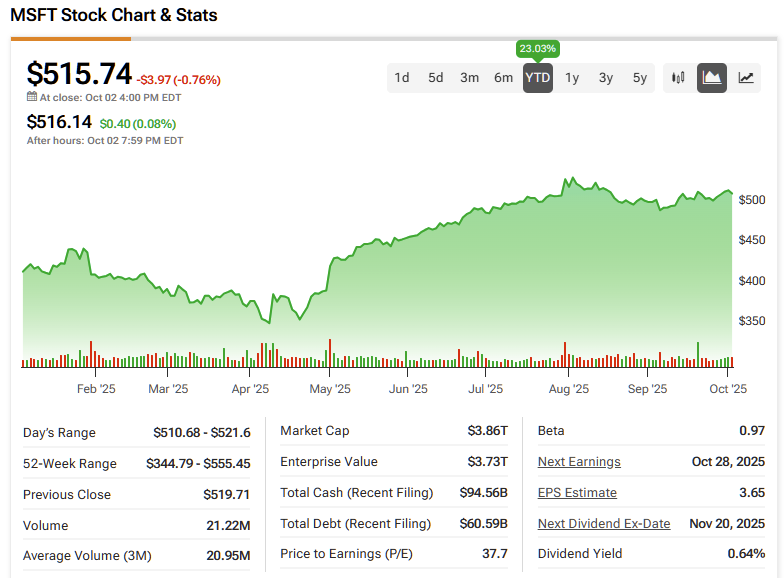When Microsoft (MSFT) closed above $500 per share for the first time in July this year, it marked not just a record valuation, but validation of a bold corporate experiment: turning one of the world’s largest technology companies into a sprawling empire of multiple CEOs. Fast forward to this week, Microsoft elevated Judson Althoff to CEO of its commercial and consumer businesses, formally distributing executive authority across a slate of high-profile leaders.
Claim 50% Off TipRanks Premium and Invest with Confidence
- Unlock hedge-fund level data and powerful investing tools designed to help you make smarter, sharper decisions
- Stay ahead of the market with the latest news and analysis so your portfolio is always positioned for maximum potential
Satya Nadella remains at the helm as overall CEO, but the leadership chart now reads more like a constellation than a hierarchy. Althoff oversees Microsoft’s vast customer-facing divisions, Mustafa Suleyman drives AI strategy, Ryan Roslansky leads LinkedIn and Microsoft Office, and Phil Spencer directs Gaming.
“We have Satya Nadella – responsible for running all businesses within MSFT,” Althoff told CNBC. “I run our commercial business, it’s the largest business that we have that serves hundreds of thousands of companies, as well as governments, around the world.”
This restructuring is more than cosmetic. Microsoft’s latest financials demonstrate that decentralization has not led to fragmentation. On the contrary, Microsoft Cloud surpassed $168 billion in annual revenue, up 23%, with Azure alone topping $75 billion. Commercial bookings crossed $100 billion for the first time, up 37%. “Copilot is the fastest growing product we’ve ever had,” Althoff said, noting the company has already created 3 million Copilot agents. More than 800 million people now use Microsoft’s cloud and AI platform monthly.
For Nadella, the redistribution of responsibilities frees him to pursue what Althoff called a “founder-mode” approach. “My appointment allows Satya to be in founder-mode and think about the future of AI from silicon to models, while I will be focused on delivering on our product strategy, roadmap, and engineering deliverables to create solutions for our customers,” Althoff explained.
The question now circulating in boardrooms and trading floors is whether Althoff has eyes on becoming Nadella’s successor. Asked directly on CNBC whether he could one day ascend to the very top role, Althoff dodged, fueling speculation that the succession storyline is already unfolding.
LinkedIn’s Independence Sparks Spin-Off Rumors
One test case for the multi-CEO model may come from LinkedIn. With 1.2 billion members and engagement at all-time highs, the professional network now “runs like an autonomous company within Microsoft,” as Althoff described. Analysts increasingly see the potential for LinkedIn to be spun off, either as an independent entity or as part of a strategic reorganization to unlock shareholder value. Ryan Roslansky, CEO of LinkedIn and Microsoft Office, already operates the division as if it were a standalone entity.
Even with challenges in legacy server sales (down 2%) and heavy capital expenditures of $24.2 billion to expand data center capacity, investors seem unfazed. Microsoft delivered $281 billion in total revenue for the fiscal year, up 15%, while Dynamics 365 revenue jumped 23% and Gaming climbed another 10%. The company also announced the world’s first operational deployment of a Level 2 quantum computer, underscoring its relentless push into frontier technologies.
Althoff insists the strategy is rooted in mission, not management structure. “We’re a company that empowers humanity,” he said. “Models will be fit for purpose for the scenarios that they serve.” With the stock consolidating above $500 per share, Wall Street seems to believe him.


















